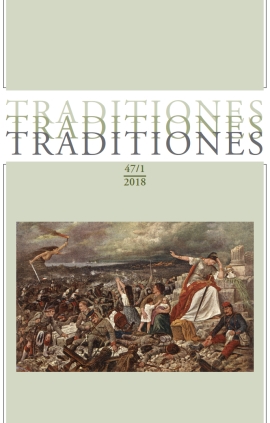Contested Heroes – Gavrilo Princip and Rudolf Maister as Subcultural Icons
DOI:
https://doi.org/10.3986/Traditio2018470112Keywords:
Gavrilo Princip, Rudolf Maister, Mlada Bosna, Franz Ferdinand, Sarajevo, Maribor, hero, assassin, World War I // Gavrilo Princip, heroj, atentator, prva svetovna vojnaAbstract
In the article, the author deals with two heroes: - Gavrilo Princip (1894-1918) was a member of Mlada Bosna, who shot at an archduke, to the successor to the Habsburg throne, Franz Ferdinand; - general Rudolf Maister (1874-1934) was a poet and commander of the South Slavic forces in the lower Styria and Carinthia in the years 1918 and 1919. The author analyzed forty-three examples of graffiti and street art pieces of different formats (graffiti, stencils, stickers, murals etc.), dedicated to Princip and Maister. Theoretically, his research combines graffiti and street art studies with a critical analysis of cult of personality of political leaders.
***
V članku avtor obravnava dva heroja, Gavrila Principa (1894-1918), člana Mlade Bosne, atentatorja, ki je streljal na nadvojvodo, na naslednika habsburškega prestola Franza Ferdinanda; in na generala Rudolf Maistra Vojanova (1874-1934), pesnika in poveljnika južnoslovanskih sil na spodnji Štajerski in Koroški v letih 1918 in 1919. Avtor je analiziral 43 primerov grafitov in uličnih umetniških del različnih formatov (grafiti, šablone, nalepke, freske itd. Raziskava združuje študije grafitov in uličnih umetnosti s kritično analizo kulta osebnosti političnih voditeljev.
Downloads
References
Barthes, Roland. 1993. Mythologies. New York: The Noonday Press.
Castleman, Craig. 1999. Getting Up: subway Graffiti in New York. Cambridge: The MIT Press.
Chaffee, Lyman G. 1993. Political Protest and Street Art – Popular Tools for Democratization in Hispanic Countries. Westport: Greenwood Press.
Čolović, Ivan. 2011. Za njima smo išli pjevajući: Junaci devedesetih. Zagreb: Pelago.
Čolović, Ivan. 2016. Smrt na Kosovu polju. Belgrade: Biblioteka XX vek.
Deák, István. 1990. Beyond Nationalism – A Social and Political History of the Habsburg Officer Corps 1848-1918. Oxford: Oxford University Press.
Deák, István. 1996. The One and the Many. In: Nader Mousavizadeh (ed.), The Black Book of Bosnia: The Consequences of Appeasement. New York: Basic Books, 5‒19.
Debord, Guy. 1994. Society of Spectacle. New York: Zone Books.
Dedijer, Vladimir. 1978. Sarajevo 1914. Belgrade: Prosveta.
Dragićević Šešić, Milena. 2014. Politike sećanja i disonantno nasleđe Balkana. Niš: Balkanske sinteze, 63‒77.
Galántai, József. 1989. Hungary in the First World War. Budapest: Akadémiai Kiadó.
Girardet, Raoul. 1986. Mythes et mythologies politiques. Paris: Editions du Seuil.
Jezernik, Božidar. 2013. Temeljni kamen kot kamen spotike – Vidovdan med Slovenci. V: Božidar Jezernik, Ingrid Slavec Gradišnik, Mitja Velikonja (eds.), Politika praznovanja – Prazniki in oblikovanje skupnosti na Slovenskem. Ljubljana: Znanstvena založba Filozofske fakultete, 17‒46.
Kropej, Monika. 2016. Rudolf Maister as a Symbol of Extreme Nationalism in Slovenia (conference paper). Conference City, Symbols, Nationalism. Skopje 18.5. & 19.5.
Lampe, John R. 1996. Yugoslavia as History – Twice There Was a Country. Cambridge: Cambridge University Press.
Lipsitz, George. 1997. Time Passages – Collective Memory and American Popular Culture. Minneapolis: University of Minnesota Press.
Lovata, Troy and Elizabeth Olton. 2015. Understanding Graffiti – Multidisciplinary Studies from Prehistory to the Present. London: Routledge.
Lukec, Katarina. 2016. “Za jedne on je heroj, a drugima je zločinac” – Gavrilo Princip u popularnoj kulturi 100 godina nakon sarajevskog atentata. Studia ethnologica Croatica 28 (1): 315‒337.
MacKenzie, David. 1989. Apis: The Congenial Conspirator – The Life of Colonel Dragutin T. Dimitrijević. Boulder: East European Monographs.
Mojzes, Paul. 1994. Yugoslavian Inferno: Ethnoreligious Warfare in the Balkans. New York: Continuum.
Mønnesland, Svein. 2013. National Symbols in Multinational States: The Yugoslav Case. Oslo: Sypress Forlag.
Novaković, Jelica and Sven Peters. 2015. Posledice jednog pucnja. Belgrade: Clio.
Ottomeyer, Klaus et al. 2000. Haiderjev Show. Ljubljana: Študentska založba (Časopis za kritiko znanosti, domišljijo in novo antropologijo, 2).
Popović, Milica. 2016. To Whom Does Gavrilo Princip Belong? (Conference paper). ASN Convention. New York: Columbia University.
Rieff, David. 1995. Slaughterhouse – Bosnia and the Failure of the West. New York: Simon & Schuster.
Saukko, Paula. 2003. Doing Research in Cultural Studies – An Introduction to Classical and New Methodological Approaches. London: Sage.
Stojanović, Dubravka. 2010. Ulje na vodi: Ogledi iz istorije sadašnjosti Srbije. Belgrade: Peščanik.
Toš, Niko et al. 2004. Vrednote v prehodu III. – Slovensko javno mnenje 1999-2004. Ljubljana: Fakulteta za družbene vede, IDV - CJMMK (Zbirka Dokumenti SJM, 10).
Toš, Niko et al. 2016. Vrednote v prehodu X. – Slovensko javno mnenje 2010-2016. Ljubljana: Fakulteta za družbene vede, IDV - CJMMK (Dokumenti SJM, 24).
West, Rebecca. 1943. Black Lamb and Grey Falcon – A Journey Through Yugoslavia. New York: The Viking Press.
Downloads
Published
How to Cite
Issue
Section
License
Authors guarantee that the work is their own original creation and does not infringe any statutory or common-law copyright or any proprietary right of any third party. In case of claims by third parties, authors commit their self to defend the interests of the publisher, and shall cover any potential costs.
More in: Submission chapter






